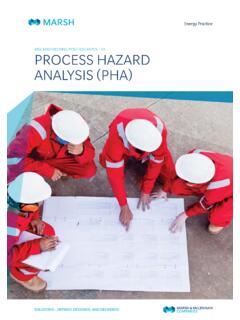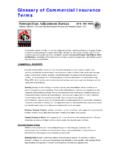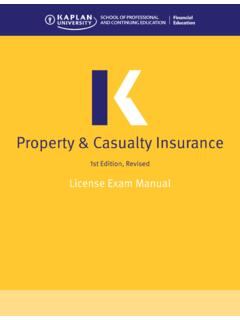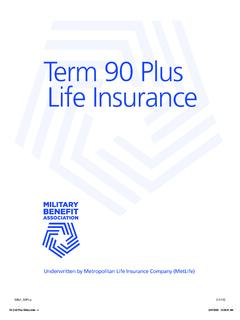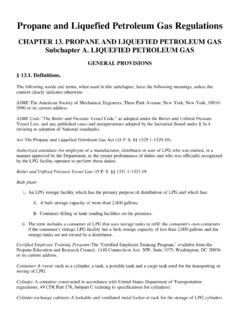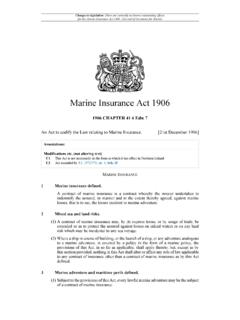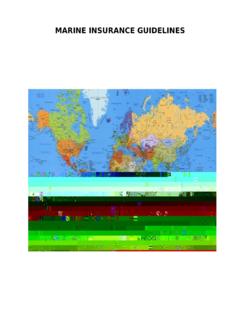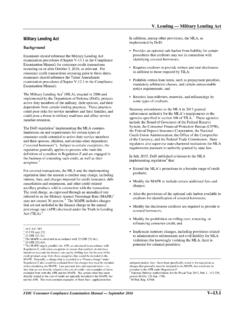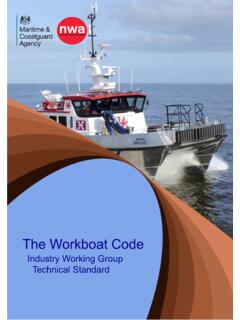Transcription of Insurance clauses in Construction Contracts
1 INSIGHTS AP R I L 2019 Insurance clauses in Construction ContractsINSIGHTS AP R I L 2019 Insurance clauses in Construction ContractsCONTENTSI ntroduction ..1 The Basics of Insurance ..2 When does a policy respond to an event? ..3 What makes up an Insurance policy document? ..3 Policies not referred to in 2013 NZS suite ..42013 NZS Insurance clauses ..6 Marsh 1 IntroductionThis paper discusses the basics of Insurance and what it covers, how Insurance responsibilities affect the parties risks and the potential cost of a project, and issues arising from the general conditions and how they are sometimes paper uses the 2013 NZS suite (3910, 3916, and 3917) as the standard Construction Contracts , although the principles also apply to other standards such as NZS3915, the NZIA standard conditions of contract , FIDIC, NEC, and other international standards. The 2013 NZS suite was chosen as it accounts for approximately 2/3 of the Contracts that Marsh reviews for our GARDNERHead of Construction Specialty NZMarsh, New Zealand2 Insurance clauses in Construction ContractsThe Basics of InsuranceInsurance is a contract between the Insured (the first party) and the Insurer (the second party) that sets out the Insurer s promise to pay a specified amount at a future time if a defined event occurs.
2 These events broadly break down into the following groups:DAMAGE TO SPECIFIED PROPERTY OWNED BY THE FIRST PARTY OR THAT THE FIRST PARTY IS RESPONSIBLE FOR, SUCH AS: Buildings, contents, and stock (Material Damage / Industrial Special Risks / Property Damage) Property in the course of Construction , erection, demolition, alteration ( contract Works / Construction All Risks / Erection All Risks / Ship-builders) Property in transit either internationally or within the country (Marine Cargo / Marine Transit) Vehicles or mobile plant required to be registered for road use (Motor Vehicle) Watercraft (Marine Hull) Aircraft powered or unpowered, includes unmanned aerial devices / drones (Aviation Hull) BODILY INJURY TO FIRST PARTIES (INCLUDING EMPLOYEES) Cover for medical costs incurred due to defined injury or illnesses (Medical Insurance ) Loss of income arising from accident and in some cases from illness (Income Protection) Capital benefit for permanent disablement / impairment arising from injury or illness (Personal Accident)
3 Capital benefit payable to the estate of the deceased on their death from any cause (Life Insurance )LOSS OF PROFIT FOLLOWING DAMAGE TO PROPERTY OWNED BY THE FIRST PARTY Reduction in revenue Increase in expensesLIABILITY TO THIRD PARTIES FOR LOSSES THEY SUFFER RESULTING FROM FIRST PARTY ACTIVITIES Property damage or injury arising from the use of first party property: use of motor vehicles (Motor vehicle liability) use of aircraft (Aviation liability) use of watercraft (Marine Liability) business activities (Public / general liability) damage caused by the first party s product once it has been handed over (Products liability / completed operations) Failure to supply goods or services following damage to property Financial loss arising from first party provision of professional advice or professional services (Professional Indemnity) Fines and penalties arising from accidental breach of certain statutes (Statutory Liability)Marsh 3 When does a policy respond to an event?
4 For an Insurance policy to respond, the insuring clause must be triggered there must be an event that fits within in the criteria of the insuring clause, such as damage to insured property for a Material Damage policy or an allegation of damage to property owned by a third party for a Public Liability that the policy trigger has been met, the second test for Insurance cover is to determine whether a policy exclusion applies. Policy exclusions are added to policies for various reasons, including: Business risks (such as failure to meet a specified standard, or poor workmanship) Inevitable damage (such as wear & tear, gradual deterioration, although consequences of such are usually covered) Moral hazard / public policy issues (such as deliberate acts, failure to comply with law) The accumulation across multiple policies arising from one event would be too large for the Insurance industry ( war, nuclear risks, terrorism) Liability assumed by agreement beyond what would exist at common or statute law (commercial decisions to accept a higher standard of responsibility than would otherwise apply) The exposure is more specifically insured under another policy (such as excluding liability for motor vehicle operations under a public liability policy)
5 Some of these exclusions are limited to the direct cause only with the consequent damage being covered (for example, defects exclusions will typically exclude the defect itself but write back cover for damage or loss caused by the defect), while other exclusions operate to totally exclude all cover for loss arising from the excluded peril (for example war and terrorism risks).What makes up an Insurance policy document?A complete Insurance policy contains several sections that each has their own purpose: The Policy Schedule the specifics of a particular policy (who the parties are, what the amounts of Insurance are, the duration of the Insurance , etc.) The Insuring Clause what the trigger is (what is the risk that is being addressed by the policy) Policy Conditions how the policy is administered, and what each party s obligations are under the policy Exclusions what is not covered by the policy Extensions / Memoranda any extensions or modifications to the policyInsurance policies can also be amended by adding endorsements to extend or reduce cover on a case by case Insurance policy document fits together in a similar manner as a Construction contract .
6 To use the 2013 NZS suite as an analogy: Insurance POLICY ITEMNZS SUITE EQUIVALENTP olicy scheduleFirst scheduleInsuring clause (policy trigger) contract agreementPolicy conditions, exclusions, and extensionsGeneral conditions of contractPolicy special endorsementsSecond schedule4 Insurance clauses in Construction ContractsPolicies not referred to in 2013 NZS suiteMost standard Contracts will address the Insurance specifications for contract works, existing structures, public liability, motor vehicle liability, damage to contractor s equipment, and professional indemnity. However, the 2013 NZS suite is silent on the following types of Insurance (although not all of these policies will be necessary or appropriate for every project): Delay in Start Up (DSU) / Advance Loss of Profits (ALOP) Marine cargo (International shipments only contract works policies are usually required to insure materials for incorporation into the works whilst in transit within the country) Use of aircraft / drones Use of watercraft Pollution Insurance Statutory liabilityDSU / ALOP INSURANCEDSU / ALOP Insurance provides cover for a loss of revenue or increase in the cost of working that is caused by damage to the works of a type that would be covered by the contract works policy.
7 The contractor usually has no insurable interest in this policy, so the contract does not generally need to address this cover, although the principal should consider the exposures for this type of Insurance before making a decision on who is to be responsible for arranging the contract works Insurance ; this is because the DSU / ALOP Insurance must be placed with the contract works insurer. While it can be possible for the contractor s Insurance adviser to arrange DSU / ALOP Insurance for the principal, where DSU Insurance is required, it is generally best for the principal to supply the contract works CARGOM arine cargo Insurance should usually be the responsibility of the party responsible for ordering the materials from overseas suppliers, (although where DSU / ALOP Insurance is appropriate the principal is usually better served to arrange the marine cargo Insurance for the project). Generally, the responsibility for marine cargo Insurance is left with the contractor to arrange as they are normally arranging the purchase of on the terms of purchase and transfer of the risk of damage, supplier s marine Insurance can be used instead of the contractor arranging this Insurance .
8 Care should be taken when relying on supplier s Insurance as: Incoterms1 set out who is to arrange the Insurance , but do not specify anything further such as the level of cover, the basis of settlement, or the policy deductible. Overseas suppliers will generally have arranged Insurance with insurers in their home territory, which can lead to issues when dealing with the insurer in the event of a claim such as language barriers, access to Insurance representatives, and a lack of commercial relationship to leverage in the claim OF AIRCRAFT / DRONESW hile the use of small drones can be accommodated under standard general liability policies, if a large drone or a manned aircraft is intended to be used for the Construction project, it is appropriate to add some specifications for aviation Insurance . If a project will require the use of manned aircraft, then aviation liability Insurance will need to be addressed by the contract usually in the form of requiring that the aircraft operator have adequate liability Insurance and that the principal and contractor are covered for their vicarious exposures arising from the use of the RC R A F TGeneral liability policies will usually include cover for liability arising from the use of small watercraft (typically up to 8m in length, although some insurers will agree to increase the maximum length), however where larger vessels (including barges or pontoons) are required for a project, specific marine liability Insurance should be addressed by the contract in the same manner as discussed above for aviation Incoterms rules or International Commercial terms are a series of pre-defined commercial terms published by the International Chamber of Commerce.
9 They are widely used in International commercial transactions or procurement processes. A series of three-letter trade terms related to common contractual sales practices, the Incoterms rules are intended primarily to clearly communicate the tasks, costs, and risks associated with the transportation and delivery of 5 POLLUTIONMost Insurance policies will contain exclusions relating to pollution damage or liability. Generally, Insurance will exclude pollution unless it can be traced to a specific event lasting no more than 24-72 hours (depending on the policy).Traditionally it has been time consuming and expensive to get any Insurance cover for pollution with extensive testing of specific sites required to obtain cover, but over the last 5-10 years insurers have developed a wider appetite for pollution cover with two policies insuring pollution liabilities becoming more readily available on commercial terms : Contractors Pollution Liability covers the exacerbation of an existing pollution condition or the development of a new pollution condition as a result of Construction works Premises Pollution Liability covers new pollution conditions that occur as a result of operational activitiesIn addition to covering liabilities to third parties, these policies can also cover actions by regulators (such as requiring that a spill into a stream be remediated), damage to first party property, and interruption to liability cover should be considered for projects involving removal of asbestos, remediation of contaminated land, or work in or adjacent to environmentally or culturally sensitive LIABILITYThis policy insures defence costs, reparation costs, and fines arising from accidental and non-reckless breach of statute.
10 Breach of specific acts are not covered, typically those where criminal intent is required, and fines and penalties under WorkSafe legislation cannot be 2013 NZS suite does not require that this Insurance be arranged, and not all contractors choose to purchase this Insurance as the Construction industry is seen as high risk by insurers making the Insurance uneconomic for some can sometimes seek to be added to the contractor s Insurance for loss that they incur arising out of the contractor s acts or omissions. This is something that insurers will strongly push back on, and it is unlikely that this requirement will be accepted by insurers; the only way for this requirement to be met is for a project specific policy to be placed, which will add cost to the from issues with dual insurance2, the principal has separate duties to the contractor under WorkSafe legislation; when a principal is prosecuted, they are being charged for their own breaches rather than the contractor s breaches, so vicarious liability cover does not Dual Insurance where multiple policies potentially cover the same loss, the insurer for whichever policy is claimed upon can seek a contribution from the insurer of the other Insurance policy unless there is a clear priority between the policies as to which policy is to Insurance clauses in Construction Contracts2013 NZS Insurance ClausesCLAUSE / EXCEPTED RISKS & FORCES OF NATURE TO BE INSUREDC lause sets out the perils of the forces of nature that are required to be insured; while this is specifying Insurance cover, it also acts as a risk allocation between the contractor and the principal.

